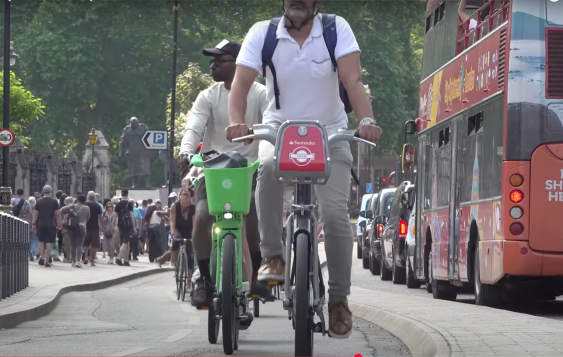
Of all the ways you can use your Clipper smart card for payment on transit agencies throughout the Bay Area, you probably didn't realize you could use it like a credit card, spending up to $10 more than the value on the card. And you probably didn't realize it's set up with the perverse economic incentive to game the system, whereby you can scam distance-based fare operators like BART out of most of the cost of your trip.
Or maybe you did and you hoped to fly under the radar?
Here's how the scam works, and mind you it is especially effective on BART, where you don't have fare inspectors or conductors to check your Clipper card and catch you. At any retailer or vending machine that sells Clipper, load the minimum $2 dollars on a new Clipper card. Buy a bunch of them this way, if you like. Pay cash and do it at a Muni Metro vending machine in downtown San Francisco if you really don't want to be traceable. Then ride BART where ever you desire and you will never have to pay more than $2.
Let's take Civic Center to the San Francisco Airport, a trip I made over the weekend to see if the scam worked as a Streetsblog tipster had suggested. I bought two $2 cards at the vending machine, paying $4 in cash. When I tagged into the system at the fare gate, the card had a $2 value. I rode to SFO, a trip that should have cost me $8.10. When I tagged out at the International Terminal fare gates, instead of an "Insufficient Fare" warning, which I would have seen had I been using a $2 traditional BART fare card, my Clipper card subtracted $6.10, leaving me with a balance of $3.90 of someone else's money.
After completing my return trip to Civic Center with my other $2 Clipper card, I ended up with $16.20 worth of BART rides for $4. If I had entered BART at one of the terminus stations, like Pittsburgh Bay Point, and traveled to SFO round-trip, I could have gamed BART for $21.80.
Because the cards still register the negative balance, and I would have to pay that down before I could add a positive balance to the card upon re-loading it, the smart thing to do would be to throw away the cards. At a cost of $2 per card to manufacture, I'm essentially paying for the privilege of adding two pretty blue cards to the landfill.
What a steal!
Of course, someone has to pay for the scam and that would be the Metropolitan Transportation Commission (MTC), the regional transportation planning body that administers Clipper (though in the end it's the taxpayer who foots their bill). MTC settles its Clipper debts every day with the transit agencies participating in the program, so BART would have been repaid the cost of my trips from regional funds allocated to the Clipper roll-out.
MTC spokesperson John Goodwin acknowledged that Clipper cards can "go negative," which he said the MTC programmed into the card to help customers get out of a transit system where there aren't fare machines or customer service personnel to help them add value to their cards.
"It's a built-in convenience to the system, based on the goodwill that people will re-load their card," said Goodwin.
According to Goodwin, Streetsblog's inquiry represented the first time an "enterprising journalist blew the lid off this" (actually, Stanley Roberts at KRON appears to be first). He said the Clipper program managers were looking into whether or not there is "wide-spread abuse of this system," though he acknowledged that they had not determined what the threshold was for that abuse. He also acknowledged that MTC "wouldn't be able to answer precisely the question how many people are scamming the system."
He could say that in August, the most recent month for this data, there were only 152 cards out of more that 100,000 that had only been used once. He also knew that in October 5 percent of 247,700 Clipper cards in use had a negative balance. Beyond that, the agency had not finished evaluating the potential for this type of fraud. Goodwin said the "ability to go negative is a standard feature in most smart-card programs" and he said he believed that "north of 95 percent are using the card correctly."
"We designed the system based on an expectation that the vast majority of our customers are honest," he added.
Though MTC has no current plans to reprogram the software to eliminate the ability to go into debt on the card, Goodwin said there were numerous options at their disposal if they thought there was widespread abuse, including lowering the card's debt balance or charging a small amount for each card.
BART's spokesperson Linton Johnson said his agency knew of the scam, calling it "Clipper's dirty little secret," but he declined to provide further comment on the matter.
Tom Radulovich, a BART Board director, said he was disappointed with MTC, which he said was botching the implementation of Clipper. "One of the things we were promised with [Clipper] was that it would be harder to scam the system, but it turns out there is a pretty easy way," he said.
Radulovich said he had tried to get BART staff and MTC to retrofit BART's Add-Fare machines in its stations to accommodate Clipper, but MTC was reluctant, preferring to rely on retail outlets like Walgreens to fulfill that role. While that might make sense in downtown San Francisco, it was a ridiculous proposition at a BART station like Orinda, he said.
"They didn't want to retrofit the Add-Fare machines. They didn't want to pay for that. They've not been willing to put the money forward," he argued.
Radulovich said MTC could avoid the scam by making the debt option possible only for someone who registers their card with Clipper so they have a record of the user. But, he argued, MTC were transportation planners, not operators, and they didn't have experience with customers like BART did.
"They've been in such a rush to declare success, they don't care if agencies are losing money," he said. "Scamming the BART system is a flaw and that is definitely something they should fix."





